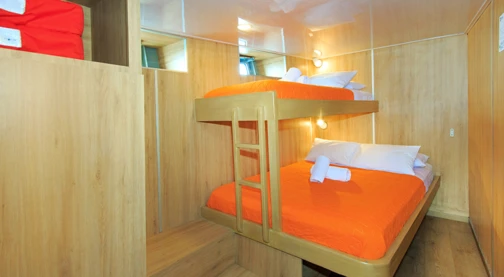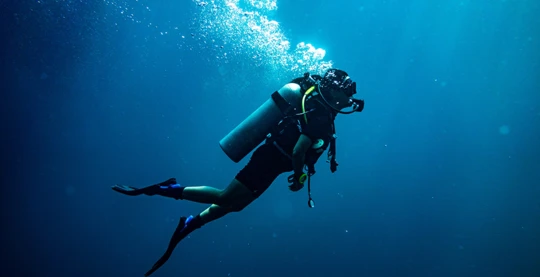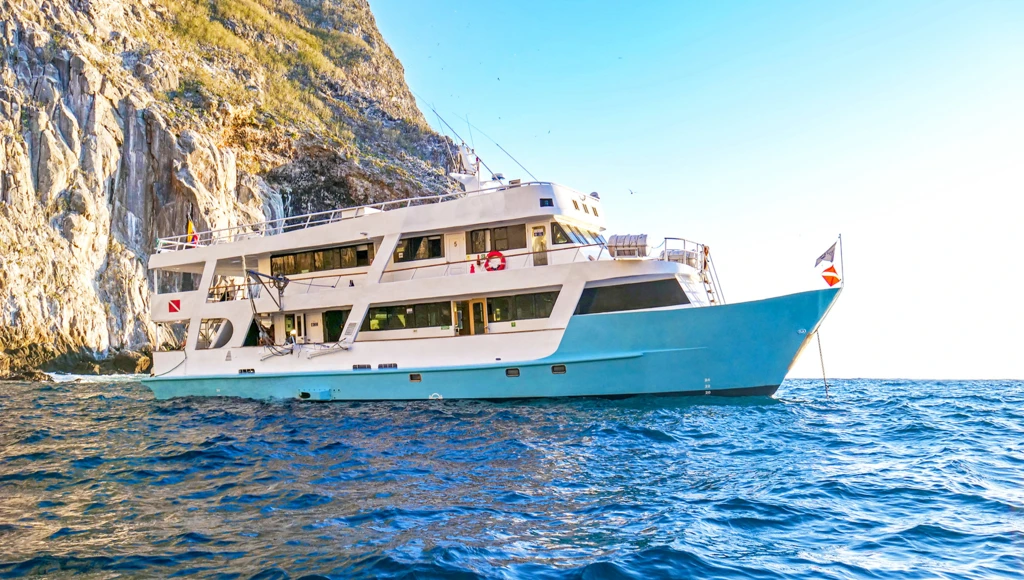

8 days of underwater adventure in the Galapagos: guided dives, encounters with whale sharks and other marine species
Main features
Boat type: yacht
Number of cabins: 9
Maximum capacity: 16 travelers
Crew members: 12
Cabins
Double Cabin – Lower Deck
Capacity: 2 Berths maximum
Located below the waterline, these cabins are ideal for families or small groups. There are two configurations: two cabins with a lower double bed and an upper single bed, and one cabin with bunk beds. All offer a private bathroom, air conditioning, practical storage, and biodegradable toiletries. Their low position provides a more stable feeling while sailing — perfect for those sensitive to the boat’s motion.
Located below the waterline, these cabins are ideal for families or small groups. There are two configurations: two cabins with a lower double bed and an upper single bed, and one cabin with bunk beds. All offer a private bathroom, air conditioning, practical storage, and biodegradable toiletries. Their low position provides a more stable feeling while sailing — perfect for those sensitive to the boat’s motion.

Double Cabin - Main Deck
Capacity: 2 Berths maximum
The main deck offers a single double cabin with a lower double bed. A notable advantage: direct access to the social areas — lounge-bar, dining area, library — as well as to the dive platform equipped with two outdoor showers. Bright and well-ventilated, it features the same amenities as the other decks (air conditioning, private bathroom, storage space).
The main deck offers a single double cabin with a lower double bed. A notable advantage: direct access to the social areas — lounge-bar, dining area, library — as well as to the dive platform equipped with two outdoor showers. Bright and well-ventilated, it features the same amenities as the other decks (air conditioning, private bathroom, storage space).

Double Cabin - Upper Deck
Capacity: 2 Berths maximum
Above the main deck, there is one double cabin (with a lower double bed and an upper single bed) and four bunk-bedded cabins. In addition to their interior comfort, they enjoy plenty of natural light and easy access to shaded outdoor areas — lounge and small forward deck. They offer an excellent balance of brightness, a friendly atmosphere, and proximity to the shared terraces.
Above the main deck, there is one double cabin (with a lower double bed and an upper single bed) and four bunk-bedded cabins. In addition to their interior comfort, they enjoy plenty of natural light and easy access to shaded outdoor areas — lounge and small forward deck. They offer an excellent balance of brightness, a friendly atmosphere, and proximity to the shared terraces.


NB : The pictures, information, and visuals presented are not contractually binding. The itinerary and program indicated may be modified without notice due to weather conditions or for technical reasons (captain's decision). Sailing times may vary depending on sea conditions and weather.
Itinerary

Baltra
AM – Baltra Airport
Upon arrival at Seymour Ecological Airport, an inspection is carried out to... more+
Upon arrival at Seymour Ecological Airport, an inspection is carried out to... more+
Breakfast
Lunch
Diner

Baltra Marshall Cape Manta
AM – Cape Marshall (Isabela)
Cape Marshall is located on the northeastern coast of Isabela... more+
Cape Marshall is located on the northeastern coast of Isabela... more+
Included activities: Scuba diving, more+
Breakfast
Lunch
Diner

Manta Darwin Bay
Due to the large number of dive sites available in Darwin and Wolf as well as the marked influence... more+
Included activities: Galapagos sharks spotting, Encounter whale sharks between June & November, more+
Breakfast
Lunch
Diner

Darwin Bay Wolf
El Arenal, Darwin
Sharks, turtles, and mackerels visit cleaning stations around Darwin's Arch to... more+
Sharks, turtles, and mackerels visit cleaning stations around Darwin's Arch to... more+
Breakfast
Lunch
Diner

Wolf
Pinnacle and the Caves, Wolf
This area has some of the best caves in the Galapagos plus a... more+
This area has some of the best caves in the Galapagos plus a... more+
Included activities: Discover underwater caves, Night dive, more+
Breakfast
Lunch
Diner

Wolf Punta Vicente Roca Douglas Cape
AM - Punta Vicente Roca, Isabela
Right at the mouth of the seahorse that Isabela Island resembles... more+
Right at the mouth of the seahorse that Isabela Island resembles... more+
Breakfast
Lunch
Diner

Douglas Cape Roca Cousin Santa Cruz
AM - Roca Cousin, Santiago
The solitary, symmetrical pyramid of Cousin Rock rises just above the... more+
The solitary, symmetrical pyramid of Cousin Rock rises just above the... more+
Included activities: Tortoise Breeding Centre, more+
Breakfast
Lunch
Diner

Santa Cruz Baltra
Transfer to Baltra airport
It's time to say goodbye to your fellow passengers and crew! Assisted... more+
It's time to say goodbye to your fellow passengers and crew! Assisted... more+
Breakfast
Lunch
Diner
included
The price includes
Unlimited water, tea and coffee on board
Airport / yacht / airport transfers (only guaranteed if passengers arrive at the scheduled meeting point, date, and time)
Full dive equipment rental (BCD, regulator, mask, fins, 7mm wetsuits, hoods, gloves, boots, torch)
Nitrox
One English-speaking certified dive guide per 8 guests
12L tanks for air, weights, belts, scuba safety equipment (personal marine rescue GPS)
Activities included in the program
Meals included in the program
The price does not include
Round-trip flight to the Galapagos Islands from mainland Ecuador, starting at : 470 $ / people
Alcoholic beverages (except those mentioned)
Travel insurance
Cancellation insurance
Diving insurance. DAN Insurance, Aquamed, or similar
All non-alcoholic beverages, except those mentioned
Meals not included in the program
Tips for guides and/or crew
Entry to the Galapagos Islands National Park - Mandatory : 200$ / people
Transit Control Card fee - Mandatory : 20$ / people
Additional information
The yellow fever vaccination certificate must have been administered at least 10 days prior to arrival in Ecuador if you have spent more than 10 days in Peru, Colombia, Bolivia or Brazil during the previous 10 days
Optional services
Flights not included in the programme are available on request
Activities

included

included

included

included

included

included
Information about the partner
Commercial history with Filovent
New Filovent partner, no commercial history yet.












